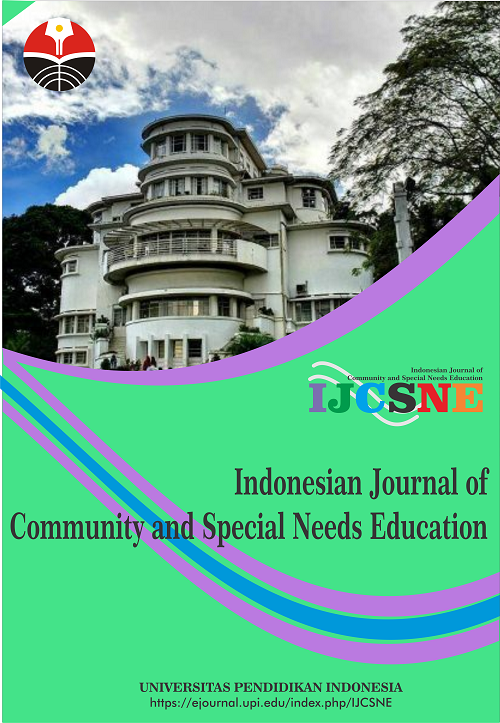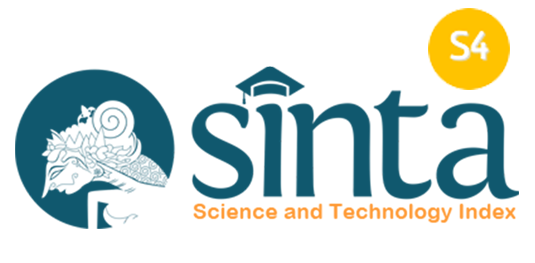Structured Approach to Diagnosis and Rehabilitation of Children with Autism Spectrum Disorder: Strategies for Effective Social Adaptation
Abstract
Keywords
Full Text:
PDFReferences
Ahmad Rizal, S., and Zainol, A. S. (2025). Exploring the efficacy of digital art therapy in enhancing social communication for autistic individuals. International Journal of Art and Design (IJAD), 9(1), 63-75.
Al Husaeni, D.N., Munir, M., Rasim, R., Santoso, Y.B., Prabawa, H.W., and Kusnendar, J. (2024). Developing computational thinking questions for upper elementary students with mild autism spectrum disorder. Indonesian Journal of Community and Special Needs Education, 4(2), 135-142.
Baird, G., and Norbury, C. F. (2016). Social (pragmatic) communication disorders and autism spectrum disorder. Archives of Disease in Childhood, 101(8), 745-751.
Bröcker, A. L., von Haebler, D., Lempa, G., and Montag, C. (2023). Mentalizing in the context of Mentzos’ dilemma–on the use of implicit work in the treatment of non-affective psychosis. Frontiers in Psychiatry, 14, 1229113.
Canu, D., Van der Paelt, S., Canal-Bedia, R., Posada, M., Vanvuchelen, M., and Roeyers, H. (2021). Early non-social behavioural indicators of autism spectrum disorder (ASD) in siblings at elevated likelihood for ASD: A systematic review. European Child & Adolescent Psychiatry, 30, 497-538.
Carlyle, D., and Graham, P. (2019). Bodies of knowledge, kinetic melodies, rhythms of relating and affect attunement in vital spaces for multi-species well-being: Finding common ground in intimate human-canine and human-equine encounters. Animals, 9(11), 934.
Clément, M. A., Lee, K., Park, M., Sinn, A., and Miyake, N. (2022). The need for sensory-friendly “zones”: Learning from youth on the autism spectrum, their families, and autistic mentors using a participatory approach. Frontiers in Psychology, 13, 883331.
Crotty, J. E., Martin-Herz, S. P., and Scharf, R. J. (2023). Cognitive development. Pediatrics in Review, 44(2), 58-67.
Dobinson, K. L., and Dockrell, J. E. (2021). Universal strategies for the improvement of expressive language skills in the primary classroom: A systematic review. First Language, 41(5), 527-554.
Gitimoghaddam, M., Chichkine, N., McArthur, L., Sangha, S. S., and Symington, V. (2022). Applied behavior analysis in children and youth with autism spectrum disorders: a scoping review. Perspectives on Behavior Science, 45(3), 521-557.
Granados, A. C., and Agis, I. F. (2011). Why children with special needs feel better with hippotherapy sessions: a conceptual review. The Journal of Alternative and Complementary Medicine, 17(3), 191-197.
Homdijah, O.S., Budiman, R.A., Maryanti, R., Sholihat, L.F., and Armindony, F.F. (2022). The use of the diorama in science learning about highlands and lowlands for children with autism spectrum disorders. Indonesian Journal of Multidiciplinary Research, 2(2), 437-444.
Housman, D. K. (2017). The importance of emotional competence and self-regulation from birth: A case for the evidence-based emotional cognitive social early learning approach. International Journal of Child Care and Education Policy, 11(1), 13.
Kalina, C., and Powell, K. C. (2009). Cognitive and social constructivism: Developing tools for an effective classroom. Education, 130(2), 241-250.
Kar, A., Mishra, D., and Srivastava, M. (2024). Therapeutic and expressive use of art therapy in children: A review. Indian Journal of Positive Psychology, 15(4), 497-503.
Kasari, C., and Smith, T. (2013). Interventions in schools for children with autism spectrum disorder: Methods and recommendations. Autism, 17(3), 254-267.
Ke, F., Whalon, K., and Yun, J. (2018). Social skill interventions for youth and adults with autism spectrum disorder: A systematic review. Review of Educational Research, 88(1), 3-42.
Kuruvilla, R. M., Rajan, S. K., and Joseph, J. (2024). Multidisciplinary, interdisciplinary, and transdisciplinary approaches to neurodevelopmental disability interventions: A brief overview. Annals of Indian Psychiatry, 8(4), 353-357.
Leadbitter, K., Buckle, K. L., Ellis, C., and Dekker, M. (2021). Autistic self-advocacy and the neurodiversity movement: Implications for autism early intervention research and practice. Frontiers in Psychology, 12, 635690.
Léger-Goodes, T., Herba, C. M., Moula, Z., Mendrek, A., Hurtubise, K., Piché, J., and Malboeuf-Hurtubise, C. (2024). Feasibility, acceptability, and perceived benefits of a creative arts intervention for elementary school children living with speech, language and communication disorders. Frontiers in Child and Adolescent Psychiatry, 3, 1322860.
Lo, H. C., and Wang, T. H. (2024). A study on the design of embedded visual image teaching aids to assist young children’s cognitive and fine motor development. Journal of Intelligence, 12(10), 102.
Makrygianni, M. K., Gena, A., Katoudi, S., and Galanis, P. (2018). The effectiveness of applied behavior analytic interventions for children with Autism Spectrum Disorder: A meta-analytic study. Research in Autism Spectrum Disorders, 51, 18-31.
Malik-Soni, N., Shaker, A., Luck, H., Mullin, A. E., Wiley, R. E., Lewis, M. E., and Frazier, T. W. (2022). Tackling healthcare access barriers for individuals with autism from diagnosis to adulthood. Pediatric Research, 91(5), 1028-1035.
Nedungadi, P., Shah, S. M., Stokes, M. A., Kumar Nair, V., Moorkoth, A., and Raman, R. (2024). Mapping autism’s research landscape: Trends in autism screening and its alignment with sustainable development goals. Frontiers in Psychiatry, 14, 1294254.
Parthasarathy, P. K., Mittal, A., and Aggarwal, A. (2023). Literature review: Learning through game-based technology enhances cognitive skills. International Journal of Professional Business Review, 8(4), 29.
Pichierri, G., Wolf, P., Murer, K., and de Bruin, E. D. (2011). Cognitive and cognitive-motor interventions affecting physical functioning: a systematic review. BMC Geriatrics, 11, 1-19.
Schaaf, R. C., Toth-Cohen, S., Johnson, S. L., Outten, G., and Benevides, T. W. (2011). The everyday routines of families of children with autism: Examining the impact of sensory processing difficulties on the family. Autism, 15(3), 373-389.
Schendel, D., Roux, A. M., McGhee Hassrick, E., Lyall, K., Shea, L., Vivanti, G., and Robins, D. L. (2022). Applying a public health approach to autism research: A framework for action. Autism Research, 15(4), 592-601.
Smith, D., Jheeta, S., Fuentes, H. V., Street, B., and Palacios-Pérez, M. (2022). Microbiome–gut dissociation in the neonate: Autism-related developmental brain disease and the origin of the placebo effect. Gastrointestinal Disorders, 4(4), 291-311.
Spreckley, M., and Boyd, R. (2009). Efficacy of applied behavioral intervention in preschool children with autism for improving cognitive, language, and adaptive behavior: a systematic review and meta-analysis. The Journal of Pediatrics, 154(3), 338-344.
Syriopoulou-Delli, C. K. (2025). Advances in Autism Spectrum Disorder (ASD) diagnostics: From theoretical frameworks to ai-driven innovations. Electronics, 14(5), 951.
Tachibana, Y., Miyazaki, C., Ota, E., Mori, R., Hwang, Y., Kobayashi, E., and Kamio, Y. (2017). A systematic review and meta-analysis of comprehensive interventions for pre-school children with autism spectrum disorder (ASD). PloS One, 12(12), e0186502.
Turkstra, L. S., Clark, A., Burgess, S., Hengst, J. A., Wertheimer, J. C., and Paul, D. (2017). Pragmatic communication abilities in children and adults: Implications for rehabilitation professionals. Disability and Rehabilitation, 39(18), 1872-1885.
Viruega, H., Imbernon, C., Chausson, N., Altarcha, T., Aghasaryan, M., Soumah, D., and Gaviria, M. (2022). Neurorehabilitation through hippotherapy on neurofunctional sequels of stroke: Effect on patients’ functional independence, sensorimotor/cognitive capacities and quality of life, and the quality of life of their caregivers—a study protocol. Brain Sciences, 12(5), 619.
Warren, Z., McPheeters, M. L., Sathe, N., Foss-Feig, J. H., Glasser, A., and Veenstra-VanderWeele, J. (2011). A systematic review of early intensive intervention for autism spectrum disorders. Pediatrics, 127(5), e1303-e1311.
Webster-Stratton, C., and Reid, M. J. (2004). Strengthening social and emotional competence in young children—The foundation for early school readiness and success: Incredible years classroom social skills and problem-solving curriculum. Infants & Young Children, 17(2), 96-113.
Yen, C., Lin, C. L., and Chiang, M. C. (2023). Exploring the frontiers of neuroimaging: a review of recent advances in understanding brain functioning and disorders. Life, 13(7), 1472.
DOI: https://doi.org/10.17509/ijcsne.v4i2.82680
Refbacks
- There are currently no refbacks.
Copyright (c) 2025 Universitas Pendidikan Indonesia

This work is licensed under a Creative Commons Attribution-ShareAlike 4.0 International License.















